Latest News
Inspiring Future Scientists & Engineers One Kid at a Time
Posted by on March 5, 2014 at 2:51 PM EDT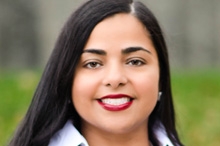
Andrea Hence Evans is being honored as an African American STEM Champion of Change.
As a child, I looked forward to my school’s science fair each year. I couldn’t wait to put on my lab coat and my safety glasses. After all, I wanted to look the part. I would proudly march into the Houston Community College’s science lab with my sharpened pencil and lab notebook ready to conduct my experiment. The College’s science professor would supervise me as I would carefully follow the scientific method. I was anxious to create my science fair board because I wanted to share my results with my peers. My family knew the importance of exposing me to science, technology, engineering and math (STEM) at an early age. Unfortunately, many parents are not knowledgeable about the important role they play in peaking their children’s interest in STEM education and careers. Or, many parents do not have access to resources available to get their children the necessary exposure. My science fair experience had a profound impact on me and I attribute my hands-on science fair experience as one of the reasons I pursued and obtained degrees in Math and Civil and Environmental Engineering degrees at Spelman College and Georgia Institute of Technology, respectively. Studies show that STEM college students were inspired to study STEM subjects because of a teacher or class.
Studies also show that by the third grade, children have permanently lost their interest in math and science. At as early as eight years old, a student is already using the dreaded “B” word and science in the same sentence. The “B” word is every parent and teacher’s least favorite word…BORING! When my daughter reached kindergarten, I searched for an exciting and fun STEM class that would engage and stimulate her. I learned that there were several STEM classes for middle school and high school students, but I was worried that if my daughter was not enthusiastic about STEM before eight years old, there would be a slim chance of her regaining interest. Thus, in 2009, I launched KIDGINEER, LLC to inspire students to excel in science, technology, engineering, and math.
KidGINEER® is a creative and fun STEM enrichment program targeting students ages five to ten years old. The program is divided into six week sessions and we focus on exposing the students to all disciplines of engineering such as civil, mechanical, chemical, computer and electrical engineering, for example. At the end of each session, we invite an engineer to speak to our students about their roles and duties as it relates to the subject matter the students have learned for the session. Students as young as five years old have built robots that have sensors that react to motion and these students can effectively communicate the science behind their robots. I truly enjoy working with elementary students to expose and help inspire them to consider careers in science and engineering. It is always a heartfelt moment to see the immense joy on our students’ faces as they see their first robot work or wire their fans, doorbells, and ceiling fans in their personalized miniature houses. Our young students are more inspired to seek out STEM programs in middle and high school and they are more likely to pursue a career in a STEM field because of this early exposure. It is important that we provide our future generations with the capability to continue to lead the world. In a knowledge-based global economy, this means ensuring that our country can ‘out invent and out innovate’ other countries around the world. We owe our children this opportunity and I am proud that I can make a positive impact on them. Lastly, I am truly grateful to be recognized by The White House as a STEM Access Champion of Change!
Andrea Hence Evans is the Principal of KidGINEER, LLC, a STEM enrichment program in the Washington DC area. She is also the owner of an intellectual property law firm, The Law Firm of Andrea Hence Evans, LLC.
Learn more about TechnologyFull S.T.E.A.M. ahead in Urban Science Education
Posted by on March 5, 2014 at 2:36 PM EDT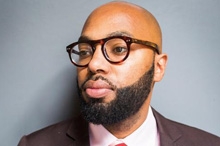
Dr. Christopher Emdin is being honored as an African American STEM Champion of Change.
Over the last few years, I have had the opportunity to visit hundreds of science classrooms. Many of them have been in the most socioeconomically challenged communities in the United States. These are communities where incarceration rates are high, graduation rates are low, and young people are so preoccupied with making it through each day that they view dreaming about a better future as a luxury they cannot afford. Like their students, educators who work within these communities are so preoccupied with the basic daily operation of schools that they see the work of creating the next generation of scientists as a luxury they cannot afford. In these communities - where seemingly insurmountable everyday challenges threaten possibilities for the future, thinking about the future or paths towards improving it are perceived as a foolhardy exercise. Oftentimes, this means that engaging students in science, technology, engineering and mathematics (STEM) is perceived as a hindrance to surviving the immediate and ever evolving everyday challenges/requirements of urban teaching.
There is a culture of immediacy that permeates many urban schools that makes it challenging for teachers to engage deeply in STEM. This culture is driven by the fact that these schools are mandated to look and sound exactly like what many consider to be the best schools - that are geographically and culturally far away from urban America. This expectation to be like the “best schools” plays out as a never-ending set of rules and expectations in urban schools that is intended to force them to have the same test results and graduation rates as schools with very different ethnic, racial, and cultural compositions. While the expectation of similar results is a necessary one, we fail to recognize that the path towards those results must look different in different schools.
If education in the most under-resourced communities becomes driven by how closely these schools can follow new mandates, shifting curriculum, and ever-evolving guidelines, educators become bound by the chase of trying to do all they are asked. They become so preoccupied with this process that they do not have the space or time to think deeply about new approaches to teaching and learning that will turn their students on to STEM careers.
As urban schools grapple with following the approaches to teaching implemented in other communities, and as they attempt to follow the cultural guidelines that are the norm in other schools, they do not have the space to focus on approaches to teaching STEM that are best for their students. Concurrently, schools who are not expected to shift their practice every new school year, and who do not have to teach any differently than they always have, continue to prepare their students for STEM careers successfully. This results in the persistent achievement gaps between schools that serve affluent culturally monolithic populations and diverse urban schools that primarily serve youth of color. In turn, these achievement gaps create a sense of alarm that results in more mandates and guidelines in communities that actually need less restriction so they can meet the unique needs of their students. As long as we expect all schools to be the same while schools that underperform are not allowed to truly engage their students, students in these schools will continue to see STEM as something for “other students” from “other neighborhoods” with “other family structures.”
Currently, STEM is seen as a set of subjects for the “best and brightest.” Historically, the best and brightest have been those with the most stable school and family structures with modes of instruction that are culturally aligned to their everyday experiences. Furthermore, the toughest or the most resilient have not been seen as being able to be a part of the best and brightest. My work challenges this history and fights the notion that students’ circumstances are an accurate tool for defining their potential academic success.
I suggest that engaging populations that are least represented in STEM requires that the classroom be malleable enough to allow the students’ unique art and culture to drive the instruction. This does not mean that we sacrifice high expectations or are less rigorous. It does mean that teaching styles must be unique to each school, and STEM instruction must be reflective of the arts and culture in the community of the school.
Incorporating the arts into STEM is part of a growing international movement called STEAM (science, technology, engineering, arts and mathematics). This approach requires that schools work with teachers to incorporate youth art and culture into the teaching, and the quality of instruction is based on how well the art and culture of the student is included in the teaching, and not on how close the urban school follows the pattern of schools in other communities. To STEAM ahead means that we use the arts to allow young people to see themselves in STEM. It validates youth who write raps about science, allows spoken word poetry about engineering concepts, and welcomes social media as a platform for sharing STEM news with youth. Moving full STEAM ahead considers motivating youth to participate, and building their self-confidence as the first two steps in preparing them for STEM careers. Most importantly, it considers the cultural art forms that youth engage in outside of the classroom as the pathways to introducing them to STEM disciplines and careers.
As a trained research scientist, I recognize the hard work required to fully engage in STEM. I have experienced the effort it takes to gain a command of the complex mathematical knowledge required to do my work. I have had to work hard to develop the skill to create and manipulate technology so I could conduct my research. I have experienced the attention to detail required to construct and test complex engineering models. However, I also realize that young people whose schools don’t allow them to see themselves as a part of STEM will never get to the point where they can appreciate the wonder and beauty of STEM.
Many say that it is easy to grab the attention of just about any child when they are introduced to a cool chemistry experiment or the physics of roller coasters. I respond by saying that in many urban schools populated by youth of color, the school is so preoccupied with trying to make students shed their culture that there is no space for innovative pedagogy that includes cool experiments and real life examples. In many schools, educators are so busy following scripts that they have no space to truly do STEM. As a result, students are so disengaged in STEM by the time they reach high school that the first time they are challenged academically, there is no passion in place to help them to overcome the academic struggle.
How is it possible that a student who is resilient enough to overcome missing meals, a broken family, and tough everyday circumstances cannot overcome the rigors of an introduction level STEM course? The answer lies in the absence of a motivation to engage. If the cultural connection to the discipline is non-existent, and the education that is being received does not ignite the passion of the student, we will not create STEM professionals. To increase access to STEM for all students, we must move full STEAM ahead. I am honored to be acknowledged by the White house for promoting this approach.
Christopher Emdin, Ph.D is an Associate Professor of Science Education at Teachers College, Columbia University, where he also serves as Director of Science Education at the Center for Health Equity and Urban Science Education.
Learn more about TechnologyUsing STEM to Create the Future You Want to See
Posted by on March 5, 2014 at 2:21 PM EDT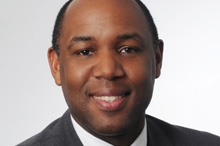
Kevin Clark is being honored as an African American STEM Champion of Change.
I am humbled and appreciative to be selected as a White House STEM Access Champion of Change for my work to support and accelerate STEM opportunities for African American students, schools, and communities. I believe STEM education has the potential to improve the educational opportunities for students who are traditionally underserved, but the mere presence of STEM resources are not enough. African Americans watch the most television and spend the most time playing video games, yet a persistent achievement gap still exists. STEM resources have the most educational impact when they are used to accomplish specific tasks and solve relevant problems.
As I think about my own STEM education, I was motivated more by not wanting to incur the wrath of my grandmother if I brought home poor grades, rather than by my high school curriculum. It wasn’t until I took my first programming class in high school that I became interested and engaged in STEM content; even if it did start with figuring out how to move a computerized turtle from one end of the screen to the other.
My STEM journey continued as I majored in computer science in college, then it took a fortuitous turn when I left graduate school to work for an educational software start-up company. It was during this time that I realized the value of my STEM education and how it could be applied to the creative design and development educational software and video games. I continue to draw form that experience and knowledge as I consult and advise arts groups, the National Parks Service, museums, and children’s media organizations on issues of diversity and the effective utilization of STEM resources.
After leaving the corporate sector for higher education, I established the Center for Digital Media Innovation and Diversity (CDMID) at George Mason University to examine issues of diversity in digital media and broadening participation in STEM disciplines and careers. The STEM For All project epitomizes CDMID’s collaborative goals by convening diverse groups of researchers, practitioners, funding organizations, and policy analysts with interest, expertise, and knowledge in positively affecting the STEM participation and opportunities of traditionally underserved students.
Another CDMID project, involved the development of a mentoring model that taught middle and high school students how to work in collaborative groups to create educational video games using STEM content. Students who consistently participated in the program showed increased confidence in their math and science abilities, which was also reflected in the improved grades they reported. Although students became engaged and motivated to create STEM-themed educational video games, many of them did not know how to achieve their newly realized dream of becoming a computer programmer, graphic artist, engineer, etc.
Students and families who begin exploring STEM pathways and learning opportunities early allow for more educational options and possibilities. The HFB STEM project provides opportunities for elementary school students to engage in robotics and technology workshops during and after-school, and for their parents to participate in academic planning workshops and information sessions.
STEM education is not a panacea, but traditionally underserved communities can use STEM skills to design digital media that captures their stories and perspectives, and equips them with the skills and knowledge to be competitive in the global economy.
Kevin Clark is a professor in the division of learning technologies in the College of Education and Human Development at George Mason University. He is also the founder and director of the Center for Digital Media Innovation and Diversity.
Learn more about Education, TechnologyThank Goodness for Pushy Dads: My #GetCovered Story
Posted by on March 5, 2014 at 10:27 AM EDTEd. note: This is cross-posted from HHS.gov
On a chilly December evening, as I was healing from a volleyball-related mild concussion, my dad came into my room and said: “Don’t you think it’s time you looked into affordable health insurance?”
He had urged me many times before to get covered, but I thought I was invincible. I’m 34 and have lived a healthy lifestyle. I thought if I ate my vegetables and drove defensively, I’d be okay. In October, in November, and into December, he pushed me to look into my options. I made a few half-hearted attempts to satisfy him, but I never took it seriously. Fortunately for me, his motto is, “Persistence beats resistance!” and he never gave up.
I was born and raised in Flint, Mich. After graduating from Michigan State University, I was no longer covered by my parents’ health insurance. The idea of purchasing my own was nowhere on my radar because I didn’t think I needed it.
Chasing my dreams, I moved to Los Angeles to try on different careers. I worked with a celebrity stylist, created a clothing line with my brother, and began acting. Feeling a spiritual calling to be closer to home, I returned to Flint and pursued an acting career in the Metro Detroit area. With auditions and bookings so infrequent, I had to find part-time jobs—including a junior varsity volleyball coach position.
With all of this uncertainty, my income frequently fluctuated; one day I was covered under the county’s health plan, and the next I was kicked off. Going from insured to uninsured was exhausting, and I finally gave up. I’ve been uninsured for most of the past 10 years.
I realize now what a dangerous gamble that time in my life was. I didn’t think about accidents or illnesses. I didn’t even think about a benign lump in my right breast that I had removed years ago under my parents’ insurance. I never considered what I would have done if a lump had returned.
I was living on the edge, one mishap away from a financial disaster!
Maybe the concussion knocked some sense into me, but I finally listened to my dad.
I logged onto Healthcare.gov and enrolled in a Silver plan that includes dental. And since I qualify for a reduced premium, the plan costs less than $100 a month.
A burden I didn’t even realize I was carrying was lifted off of my shoulders!
I received my health insurance card on my mother’s birthday, January 2nd. What a great gift to us all! My parents and I now have the peace of mind knowing that I have affordable, quality insurance. I can go anywhere and pursue my dreams because I have the confidence of knowing that I am covered.
I strongly encourage all young adults to visit the Health Insurance Marketplace at HealthCare.gov before open enrollment ends March 31 —even if, like me, you think you’re invincible. It’s easy and your options may be cheaper than you think.
I won’t say that parents always know best, but I have to admit that signing up has been a breath of fresh air. I’m so glad mine never gave up. Thanks, Dad!
“My Brother’s Keeper”: Not a Person to Spare
Posted by on March 4, 2014 at 4:24 PM EDTEd. note: This is cross-posted from United States Department of Labor.
President Obama’s opportunity agenda – his belief that success should be determined by hard work and personal responsibility, not the circumstances of your birth – extends to every American. But perhaps no community more urgently needs a hand up on the ladder of opportunity than young men of color. That’s why the president announced a new initiative last week called My Brother’s Keeper, designed to give every young man of color who is willing to work hard the chance to live out his highest and best dreams.
Opportunity remains elusive for too many young men of color. If you’re African-American, for example, you have a 50-50 chance of growing up without a father. It’s a 1-in-4 chance if you’re Latino. Fatherless boys, as the president pointed out, are more likely to be poor and to struggle in school. Black students lag behind their white counterparts in reading proficiency. By high school, black and Latino kids are more likely to have disciplinary problems and to end up dropping out, with a better chance of ending up in the criminal justice system. These are unconscionable hurdles that we have an obligation to do everything in our power to address.
My Brother’s Keeper will do so by tapping the resources and expertise of foundations, philanthropists, faith leaders, businesses leaders and more. And it will use evidence-based strategies to evaluate which federal government programs are making progress toward our goal of empowering young men of color and which aren’t. Let’s identify what works and take it to scale.
At the Labor Department, we look forward to an active role in this initiative. We are already making strong investments in programs that can help young men of color acquire the skills they need to find work and unlock their potential.
Job Corps, for example, is an intensive residential, education and career technical training program for eligible at-risk youth, ages 16 to 24, with 125 centers nationwide. Last year, more than 70 percent of new enrollees were students of color. YouthBuild helps at-risk youth and high school dropouts obtain a high school diploma or GED credential and acquire occupational skill training that leads to employment. And through our Reintegration of Ex-Offenders grants, we support successful state and local programs that improve workforce outcomes for youth ex-offenders.
The barriers to opportunity facing young men of color are a moral outrage. As long as the odds remain dauntingly stacked against them, America’s basic bargain is undermined. We can’t give up on these young people. We don’t write people off or kick them to the curb in this country. We help them find pathways to success.
Speaking more pragmatically, this is an issue of national importance – because we all have a stake in the success of all of us. We’re talking about tomorrow’s leaders and tomorrow’s workforce. We don’t have any human capital to waste. We simply don’t have a person to spare.
Tom Perez is Secretary of the United States Department of Labor.
1890 Historically Black Land-Grant Colleges and Universities: Ensuring Access to Higher Education and Opportunity for All
Posted by on February 28, 2014 at 4:52 PM EDTEd. note: This is cross-posted from USDA.gov
Earlier this week I caught up with Tom Joyner on the Tom Joyner Morning Show to announce $35 million in grant support for high quality research, teaching and Extension activities at 1890 Historically Black Land-Grant Colleges and Universities. Tom, a graduate of Tuskegee University, and I discussed how these additional resources will help support exciting new opportunities and innovative research at 1890s institutions.
These grants are just a small piece of USDA’s nearly 125 year partnership with 1890s schools to support cutting edge research, innovation and student achievement. Since 2009 alone, USDA has awarded $647 million to 1890s schools.
In addition to highlighting the great work of these universities with Tom Joyner, I also joined Congresswoman Marcia Fudge—a champion of education and an extraordinary advocate for underserved Americans—to announce the designation of Central State University, a historically black university in Wilberforce, Ohio, as a land-grant institution.
Beginning in fiscal year 2016, Central State University will be eligible to receive USDA funding to strengthen its capacity to conduct research, Extension and teaching activities. In the meantime, the university is currently eligible to apply for certain USDA competitive grants and students can apply for scholarships through USDA’s 1890 National Scholars Program (applications are due by March 14, 2014).
Partnerships with 1890s institutions are critical for two reasons.
First, working closely with 1890s institutions allows us to work more directly with the next generation of agricultural leaders. Whether they are destined for careers in communications, research, technology, and education, or to work directly in the field as farmers, ranchers, foresters and conservationists, it is important that we build strong relationships early on.
For example, at Southern University in Baton Rouge, Louisiana, scientists used USDA support to start a program to equip youngsters with the critical thinking skills necessary to prepare them for future careers. This project has increased the number of students entering food and agricultural sciences and in turn benefits rural communities, and all Americans.
Second, these partnerships further our broader mission at USDA to ensure equal access to programs and services for all of our stakeholders.
We’ve made significant progress to create a new, lasting era of civil rights at USDA: We have undertaken an initiative to focus civil rights trainings in agencies with large program complaint filings, which has resulted in three consecutive years of the lowest total volume of customer civil rights complaints in USDA’s Farm Service Agency (FSA), Natural Resources Conservation Service (NRCS), and Rural Development (RD).
We’ve settled lawsuits brought by African American farmers in Pigford II, and by Native American ranchers and farmers in Keepseagle. We have constructed a unified claims process to provide a path to justice for Hispanic and women farmers and ranchers who claim to have faced discrimination by USDA in past decades.
I am proud of what we’ve accomplished, but our work is not finished. We will continue to work towards a more diverse Department that stands ready to serve all customers with dignity and respect, and build a new legacy of equality, service and opportunity for all.
Tom Vilsack is Secretary of the United States Department of Agriculture.
Learn more aboutChampion of African American History: The Honorable Shirley Chisholm of New York
Posted by on February 28, 2014 at 3:41 PM EDT“I don't measure America by its achievement but by its potential.” – Shirley Chisolm, in her book, “Unbought and Unbossed”
With her slight build, distinctly precise diction, and relentless energy, Representative Shirley Chisholm of New York will be forever remembered for the ground she broke in Congress, and the ground she laid for millions of women, girls, and African Americans in this country.
In honor of her contributions as the first African American woman elected to the U.S. Congress, and a tireless advocate for women, African Americans, and folks who are all too often overlooked or underserved, the U.S. Postal Service has recognized Ms. Chisholm with the issuance of their limited-edition 37th Black Heritage Forever Stamp.
Born in Brooklyn in 1924, Shirley Chisholm’s childhood was split between New York and Barbados, where she lived with her grandmother. Upon graduating from Brooklyn College in 1946, she pursued a career in teaching, eventually earning a master’s degree in elementary education from Columbia University. She later served as a childcare center director, and an educational consultant for New York City’s Bureau of Child Welfare.
Shirley Chisholm was elected in 1968 as a member of the U.S. House of Representatives, representing New York as the first African American Congresswoman in that history. She spent seven terms in Congress fighting for social justice and access to quality education for all, while championing the rights and empowerment of women, African Americans, the poor.
In addition to serving on the Education and Labor Committee, and the Veterans’ Affairs Committee, Chisholm was also one of the founding members of both the Congressional Black Caucus, and the National Organization of Women, while playing a key role the passage of Supplemental Nutrition Assistance Program (SNAP) legislation.
“Tremendous amounts of talent are lost to our society just because that talent wears a skirt.”- Shirley Chisolm
In 1972, Chisholm became widely known across the country when she became the first African American to seek a major party’s nomination for President of the United States. In doing so, she challenged countless norms and shattered innumerable barriers which had stood since the dawn of our republic. And it was far from easy. She had to sue her way into televised debates, and survived multiple assassination attempts along the way. Ms. Chisolm did not earn the Democratic Party’s nomination in 1972, but she did earn a place in history, along with the boundless respect of millions of Americans for her fundamental refusal to live life within the confines of society’s expectations. Through her example, future generations gain a better appreciation for what it means to control one’s own destiny.
When she left Congress in 1983, Chisholm returned to teaching, accepting a post at Mount Holyoke College. She died on January 1, 2005 in Ormond Beach, Florida, at the age of 80.
According to the U.S. Postal Service, the stamp was designed using a painting of Chisholm by artist Robert Shetterly. The portrait is taken from a series of paintings titled “Americans Who Tell the Truth.”
Valerie Jarrett is Senior Adviser to the President and Chair of the White House Council on Women and Girls.
Learn more about Civil RightsEngaging Community Leaders On the Israeli-Palestinian Negotiations Process
Posted by on February 26, 2014 at 9:46 AM EDTIn the President’s State of the Union address, he stated, “American diplomacy is supporting Israelis and Palestinians as they engage in difficult but necessary talks to end the conflict there.” Secretary Kerry has been at the forefront of these talks and the negotiations process, and the Office of Public Engagement and his Special Envoy for Israeli-Palestinian Negotiations have come together to engage various leaders and discuss the influence and role they can have in this process.
Arab-, Israeli-, Palestinian-, Jewish-, Christian- and Muslim American youth leaders from across the country gathered at the White House for the first time earlier this month to share the work of their organizations and student groups, and to discuss ways to promote and organize efforts in support of the current negotiations process and a two-state solution between Palestine and Israel as difficult conversations currently take place in the region. These young leaders have an imperative place and role to play in this negotiations process and in the future of the conflict as next generation leaders.
Also earlier this year, Secretary Kerry joined a luncheon with Christian, Muslim and Jewish faith leaders at Georgetown university, coordinated by the Office of Public Engagement, State Department’s Office of the Special Envoy for Israeli-Palestinian Negotiations and the new Office of Faith-Based Community Initiatives launched by Secretary Kerry last summer. Imam Yahya Hendi, Cardinal Theodore McCarrick and Rabbi Sharon Brous came together to give opening prayers on the shared responsibility of people of all faiths in the Israeli-Palestinian peace process. Following the prayers from the three clergy, Secretary Kerry discussed current U.S. government efforts in the negotiations process. He also listened to the perspectives, concerns and recommendations of the various prominent faith leaders in the room, and encouraged interfaith and/or faith-based efforts to support peace in the region.
“Humanity once shared an ark, why not again?” – Imam Yahya Hendi
Rumana Ahmed is the Executive Assistant to the Director of Public Engagement.
- &lsaquo previous
- …
- 42
- 43
- 44
- 45
- 46
- 47
- 48
- 49
- 50
- …
- next &rsaquo



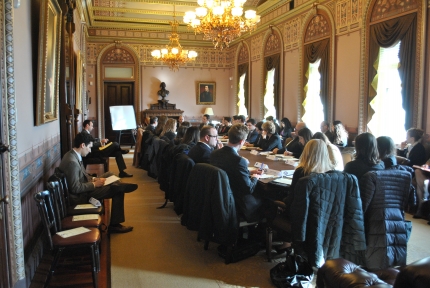
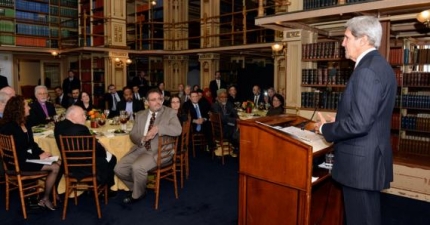
Twitter